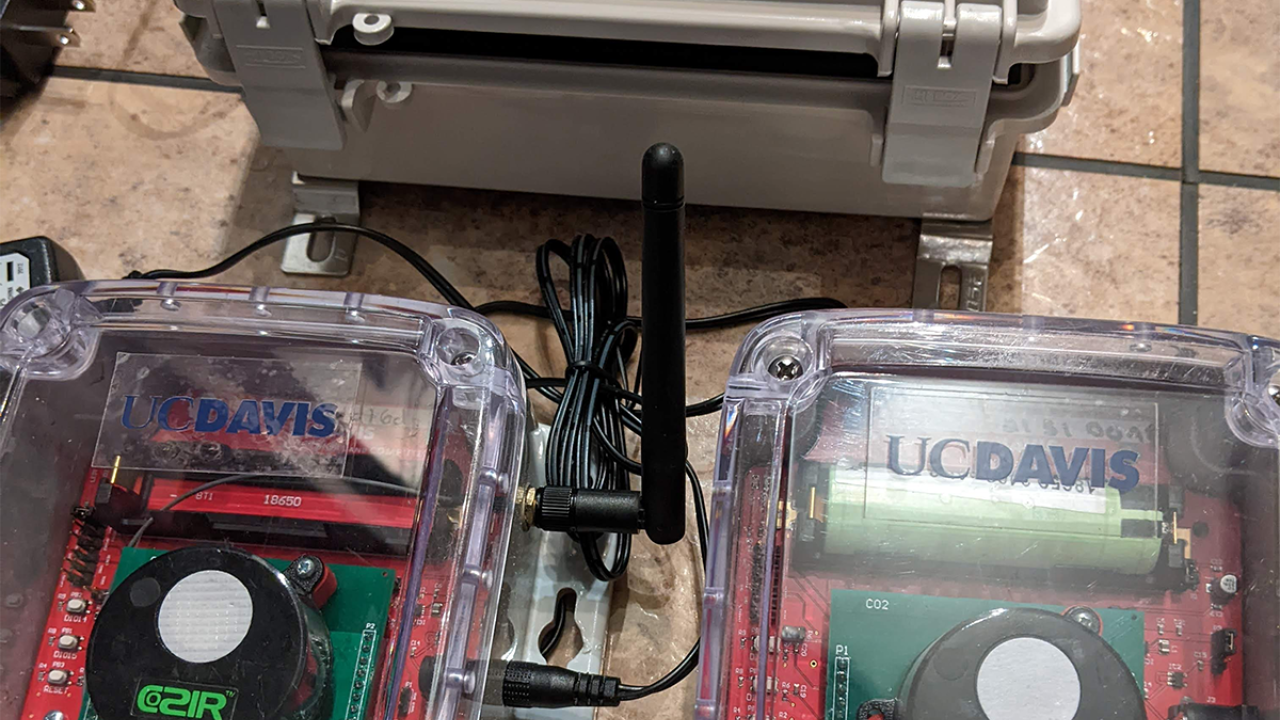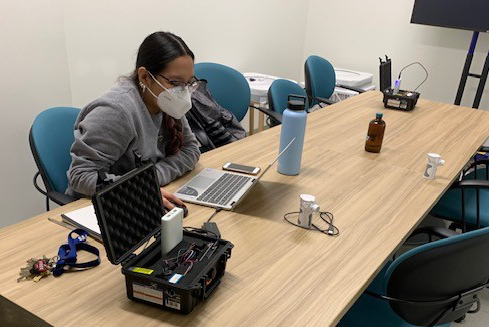
Innovative Solutions and Industry Partnerships Keep UC Davis Engineering Students, Faculty and Staff Safe
Quick Summary
- Corsi-Rosenthal air cleaners and electronic atmosphere monitoring technology adapted from the wine industry protect ECE from COVID-19
UC Davis' electrical and computer engineering department (ECE) was looking forward to in-person lab and lecture instruction in the winter quarter. However, the Omicron outbreak in December caused UC Davis to pivot to temporary virtual instruction for lecture courses during the first two weeks of the quarter. An exception was granted for critical lab courses in the College of Engineering to continue in-person labs, provided the labs met additional safety requirements.
Additional safety requirements included distributing N95 masks for students and instructors in engineering labs and ensuring that instructional labs had adequate ventilation and filtration. Fume hoods are standard in most labs, but UC Davis' ECE facilities do not typically require them. In addition, ECE needed to obtain SARS-CoV-2 virus-compliant in-room filtration units within a week to continue ten in-person critical lab courses to meet the additional safety requirements.

Corsi-Rosenthal Air Cleaners
In September 2021, the College of Engineering purchased 60 high-quality HEPA air cleaners for use in communal areas. However, given the high cost and, more importantly, the ongoing disruption in the international supply chain that precludes obtaining commercial HEPA air cleaners in a short period, ECE needed another solution.
Serendipity would have it, though, that the College of Engineering had a secret weapon. Dean Richard Corsi, who joined the College in Fall 2021, is the inventor of the Corsi-Rosenthal (CR) box, a do-it-yourself (DIY) air cleaner built at a low cost and was designed during the COVID-19 pandemic to reduce the levels of virus-laden aerosol particles in indoor settings.
After a conversation with Dean Corsi on the basics of filtration design principles, Andre Knoesen, the Chair of ECE, realized that such filtration units can exceed the performance of most commercial HEPA filters. Furthermore, they are one-quarter of the cost.
The important design parameter that must be optimized is the Clean Air Delivery Rate (or CADR), a measure of an air cleaner's efficiency at removing contaminants. Although the MERV13 filters inside the CR box may be less effective than those in a commercial HEPA device, the box can be used with fans that create greater airflow through the filters than in a HEPA filter, resulting in an entire system with a higher CADR than most standard commercial HEPA air cleaners.
While several DIY designs for the CR boxes exist, Knoesen designed a box using cost-effective and locally available supplies. Construction drawings of the ECE CR box are available for download here. ECE obtained the MERV13 filters at a steep educational discount from Tex-Aire Filters.

Knoesen and graduate student Sean Alling and Professor Diego Yankelevich constructed 10 units within five days of receiving the materials. Civil and Environmental Engineering graduate student Rachael Dal Porto and atmospheric aerosol expert Professor Chris Cappa trained ECE development engineer Lance Halstead and ECE undergraduate student, Victoria Liera, to perform particle decay measurements to evaluate the CR units.
After Liera confirmed the ECE CR units operate at required specifications, the units were deployed in all ten ECE instructional labs. In the subsequent week, the ream built 22 additional units for use in graduate communal office areas. These units were made with the assistance of Professor Diego Yankelevich. Christine Elise Mitrof, Willie Feng-Liu and Emily Hoang also developed parts by employing laser cutting skills they learned in Knoesen's EE-Emerge class.

Industry Partnership Brings Wireless Atmospheric Monitoring to ECE Labs
Professor Knoesen brought a wireless sensor system to UC Davis' engineering laboratories to observe and report air quality.
The wireless sensor system was developed two years ago by a senior design team that Texas Instruments sponsored. The wireless sensor system monitors CO2, humidity, and temperature with multiple battery-operated sensor nodes [1]. One of the design team students, James Nelson, continued as a doctoral student in Knoesen's research group.

Knoesen's group conducts research with Professor Roger Boulton in the Viticulture and Enology department on novel Industrial Internet of Things (IoT) technologies to monitor and improve wine production. The group has a long-standing collaboration with Opus One Winery in Napa Valley. Opus One Winery implemented a sensor network similar to the senior design to monitor CO2, humidity, temperature and particle count throughout the winery [2]. The sensor system is used when wine is fermented, from August to December, and has been very effective in making improvements in the air delivery system used at Opus One Winery.
On January 18, 2021, at 2:15 pm, Andre Knoesen sent Michael Silacci, the winemaker at Opus One, an urgent message: "The continued COVID period is presenting a challenge, but also an opportunity. We need to monitor CO2 and particles in as many of our undergraduate instructional labs as possible in real-time. Therefore, having access to the Opus One wireless units will be essential. The units will return to Opus One by mid-July at least." to which Michael enthusiastically responded at 2:28 pm: "Yes, of course. Life is a two-way street!" The Opus One wireless sensor network was retrieved and redeployed in four ECE laboratories within a week.

To date, twenty-three sensor pods monitor CO2, humidity, temperature and particle counts by taking samples day and night at five-minute intervals. Monitoring these parameters in space and time will allow a detailed study of the rooms' use and determine how effective the ventilation is in the labs.
The wireless sensor system project also came to the attention of John Matranga, the Director of Business Incubation and Acceleration of Aveva. In response, Matranga gave Professor Knoesen's group access to AVEVA™ Data Hub, which provides edge-to-cloud data visibility for industrial operations. The wireless sensor network installed in the ECE laboratories pushes data to the cloud-based Data Hub, enabling real-time monitoring of the labs. The wireless sensors will monitor the physical environment in four ECE labs during the winter and spring quarters.

Commitment to Safety during the Pandemic
The use of Corsi-Rosenthal boxes and the wireless sensor system monitoring demonstrates the College of Engineering's commitment to the safety of ECE instructional labs. The pivot to increase safety in the labs could not have happened without the unique partnerships across faculty, students and industry.
On January 31, in-person labs resumed at UC Davis with all students urged to use N95 respirators. Because of the college's efforts, all the ECE instructional labs and graduate communal office areas have SARS-CoV-2 filtration units. These units will also be beneficial for smoke particle reduction during future wildfires and during allergy season.
[1] J. Nelson et al., "Wireless Sensor Network with Mesh Topology for Carbon Dioxide Monitoring in a Winery," 2021 IEEE Topical Conference on Wireless Sensors and Sensor Networks (WiSNeT), 2021, pp. 30-33, doi: 10.1109/WiSNeT51848.2021.9413797.
[2] UC Davis and Opus One Using Fledge to Produce Word Class Wine in Safer Conditions

